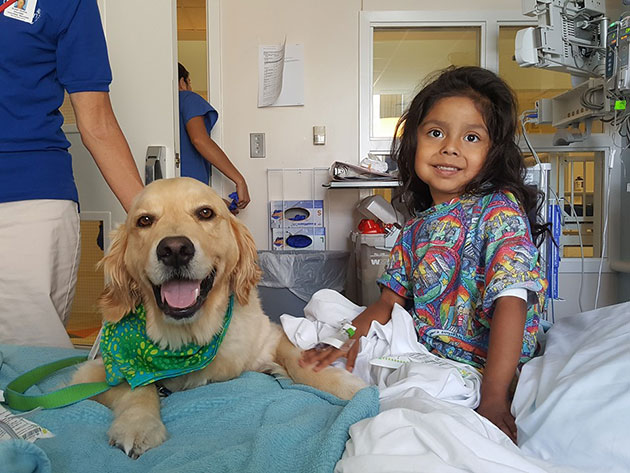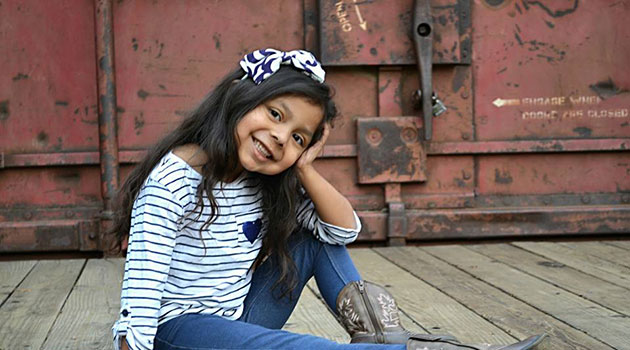It was a February day in 2014 when Tracy Reyes saw the first sign.
After her 1-year-old daughter sustained a small cut from slipping and falling while toddling around her Oceanside, California house, her energetic 3-year-old, Aleah Macias, uncharacteristically fainted. But after passing out, Aleah began convulsing, experiencing what Tracy said looked like a seizure.
Frightened, Tracy—who was 8 months pregnant at the time—called an ambulance, and had Aleah admitted to the nearest emergency room. Her vitals were checked and a number of tests were administered—all coming back normal.
“It was unexpected,” Tracy said of the incident. “I’d never seen any of my children do this. They checked her and all signs looked normal at that point. They thought she saw the blood, got upset, and fainted.”
Still, the convulsions worried Tracy, so she took Aleah to a pediatrician the following day. The doctor recommended further examinations by a neurologist and a cardiologist—and that’s how the family found out about Aleah’s heart condition.
One in a Million
While the neurologist appointment went well, the cardiologist visit was troublesome. Tests pointed to a rare ailment called restrictive cardiomyopathy, a disorder that often leads to heart failure.
A more extensive—and invasive—test was ordered to determine how serious Aleah’s condition was, and results confirmed she had the rarest form of the disease, diagnosed in 1 of every 1 million children. (Tracy received the news just four days before giving birth to her son.)
“There’s no cure or treatment,” Tracy recalls being told. “There’s some medication they can give you that makes things a little bit better, but there’s no cure, so you basically know in the future, you don’t know when, but you’re going to eventually need a transplant.”
Still, doctors told Tracy her daughter’s case was relatively mild and there was a chance Aleah could eventually grow out of the condition. Unsure how else to proceed, the family soldiered on under the motto of “Just keep an eye on it; we’ll worry when we need to worry.”
But it wasn’t long before Aleah’s seizures started up again. Two weeks after receiving the diagnoses, she had another incident. At that point, that she was admitted to Rady Children’s Hospital in San Diego, where she remained under observation for 2 weeks. “That was the first Easter she spent in the hospital,” Tracy said.
The family began regularly monitoring her condition, enduring several more fainting incidents and a terrifying airlift to a nearby hospital. Still, after every occurrence, Aleah checked out fine.
“She didn’t have the classical signs,” Tracy said. “After she would recover, she had these bursts of energy. She was so full of energy that you couldn’t contain her. She wanted to run. She wanted to play.”
About a year later, that energy started to fade, and Aleah’s condition quickly worsened.
A Serious Turn
By 2015, Tracy had joined a Facebook support group for restrictive cardiomyopathy.
After noticing her daughter’s slower pace—“She’s no longer jumping on the trampoline with her little brother and sister; I thought that was kind of weird”—Tracy checked in on Aleah one night to find her breathing strangely. Tracy took a short video of the breathing pattern and posted it to the group, asking if anyone else had seen these symptoms in their child.
“They said, ‘We think she’s going into heart failure,’” Tracy recounted. She heeded the warning and headed to the hospital.
Once there, Aleah’s condition deteriorated quickly. She was rushed to the emergency room where, as Tracy put it, “Her heart started going haywire.”
“Here I am, holding her hand, and watching my child’s heart practically stop in front of me,” she recalled, audibly choked up. “Everyone comes rushing in, but they’re putting all kinds of tubes in her and monitors in her. There’s blood everywhere. I have to be there because she doesn’t want anybody but me there—and normally, they wouldn’t even have a parent in there, but there wasn’t any time.”
Aleah survived the incident and was put in a medically induced coma for three days. Tracy was told her daughter needed a heart transplant, and needed it immediately.
“At that point, I was like, ‘God, this is in your hands,’” Tracy said. “Whatever road you have us on, we’re going to take it, but I just don’t want her to suffer. That was my prayer: ‘Just don’t let her suffer.’ And you take it a day at a time. That’s all you can do.”
Comfort—and Conflict
Aleah stayed at Rady Children’s for over 2 months following the incident, before Tracy decided to bring her home to wait for a donor.
Her condition called for a rigorous medicinal schedule, including a constant IV drip that needed to be flushed completely every 3 hours. Tracy got creative in finding ways to deliver the medicine, storing the IV bags in backpacks for Aleah decorated with unicorns or lady bugs. The move restored some normalcy—and even fun—to the family’s lives.
“She would go on the trampoline, we would have water fights, we went to the fair,” Tracy said. “Whatever she wanted to do, we would figure out a way to make it possible.”
But it was also a difficult period of time for Tracy. She was told that for a donor to be a good match for Aleah, the heart would have to be near the same size—meaning the organ would need to come from a child.
“It’s a very tough thing to assess, where the heart’s coming from,” she said. “That was very difficult to think about for me. I felt like, I don’t want to wish for her heart to come, because I know what that means. I didn’t even know how to pray about it at this point.”
She found comfort from a social worker assigned to her transplant case, who told her that the situation was ultimately out of her control, that the donor’s parents were also making a choice, and they were choosing a way to let their own child live on. Tracy was touched and encouraged by the idea.
“So my prayer became, ‘Wherever this heart is coming from, please make sure that child is loved. Please don’t let them suffer,’” she said. “It was the same prayer I had for my daughter.”
Still, even with those thoughts at least partly allayed, the mother of four felt unsure about the dangerous procedure awaiting her daughter.
“In the community, it’s believed you’re trading one problem for another, because a heart transplant is not a cure at this point,” she said. “That’s something you have to assess, too. People want their kids to live a normal life, but sometimes, because of the complexity of donating, it’s not a perfect situation—it could not be a perfect match, or the recipient can reject the organ right away. You’re still taking a chance.”
But when the call came several months later that a donor was found, she was ready to take that leap of faith.
Replacing a Battery, Remembering a Life

After Tracy was told about a possible donor match in July 2016, things started moving very quickly.
She took Aleah to the hospital to undergo last-minute tests, and once a separate transplant team confirmed the donor match, her procedure was scheduled immediately. Tracy told her brave then-5-year-old that she was simply “having her battery replaced” before sending her off to the operating room.
“At that point, you have to say goodbye to your child,” Tracy said, her voice breaking once again. “All you can do is pray—and wait.”
But while she waited for the overnight procedure to conclude, she read. Aleah’s heart had come with a letter, written by the father of the little girl who had donated it.
“The letter said, ‘I will be praying for your daughter,’” Tracy said. “It said, ‘Our daughter gave her heart with so much joy in it.’ It said she was loved. I felt that part of me was at peace at that point. I knew the heart had come from a child who was loved, that it had come from love.”
And it would go on to create even more love. Aleah not only survived the surgery but recovered quickly, returning to her usual boundless energy and curiosity within a month of the procedure.
Tracy has since reached out to the family of the donor, sending them a letter and an audio recording of Aleah’s new heartbeat. The families are slowly learning more about each other and hope to meet in person one day.
“There was a lot of love for that girl, and I can’t wait for them to meet Aleah,” she said. “They’re forever a part of us, they’re forever a part of our family. They described their little girl as having so much joy, and that’s the word I use for Aleah – ‘Joy.’”
In the meantime, 6-year-old Aleah has started kindergarten. And despite the dangers it poses to her immune system in the wake of her transplant, she asked her mother to attend public school—a request Tracy obliged.
“It’s what she wanted,” she said. “I wanted to wrap her in bubble wrap, but she’s already gone through so much and the whole purpose of a heart transplant is to give your kid the chance to live, to give her the chance to do things that may make me uncomfortable, but it’s what makes her happy.”
While another transplant is likely in Aleah’s future—the average donated heart lasts about 15 years before another procedure is typically needed—Tracy said for now, she is focused instead on enjoying each moment with her daughter.
“I don’t know what tomorrow holds, but I take it one day at a time,” she said. “You want to keep them safe, but it doesn’t mean you don’t let them jump off that rock. You need to teach them how to swim, but if they want to dive, you let them dive. You did this to let them live.”
